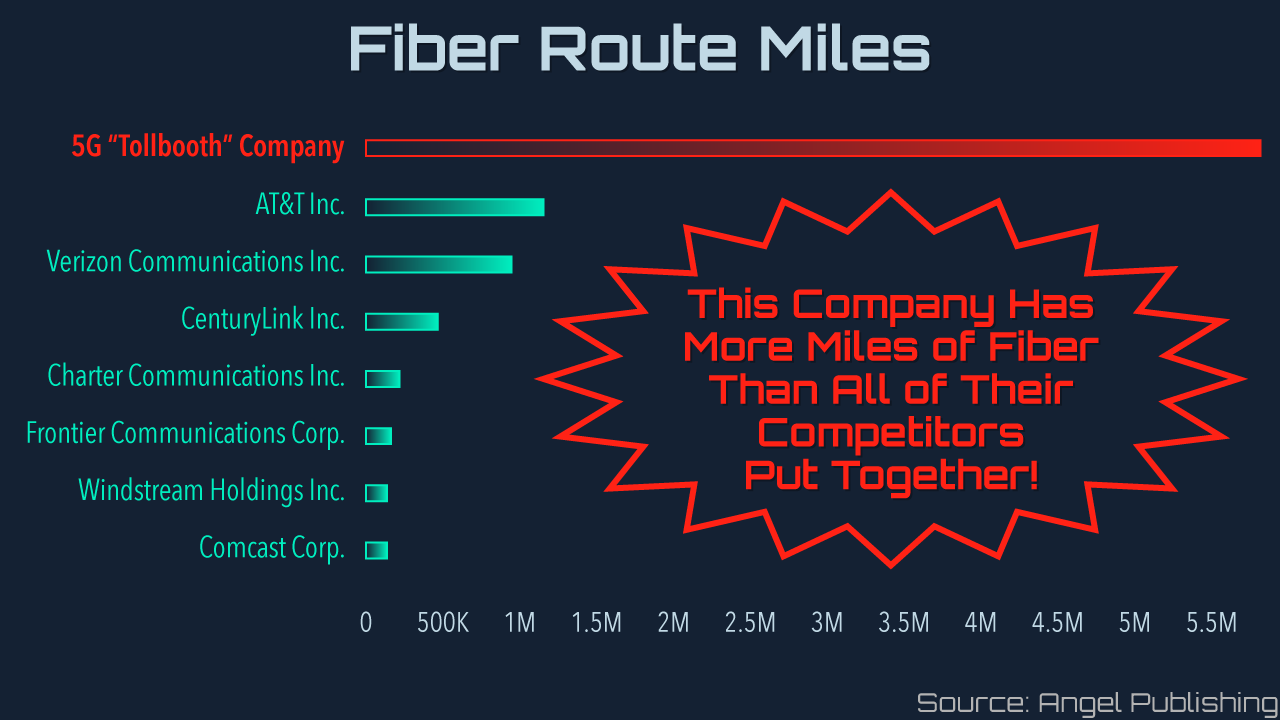Despite decades of research and what seems like decades of hype, most people in the U.S. still don’t have access to a 5G wireless network.
We’ve got the technology to build the antennas. We’ve got the capacity to store all the data. We’ve even got devices with the right chips to connect to a 5G network.
So what gives? Why don’t we have one yet?
Well, it all comes down to one thing: infrastructure.
You see, the 5G wireless network isn’t really wireless at all. It’s got to “sit” on a backbone built of physical connections fast enough to transmit data at the speeds 5G wireless allows.
And there’s one company that’s been quietly building just such a network of super-fast physical connections in anticipation of the nationwide rollout of 5G.
The Backbone We Need for the Network We Want
Before I get into the details of the company, let me give you a little background information about why its network of physical connections provides the perfect infrastructure for our 5G wireless network…
The beauty of 5G is that it’s both incredibly fast and can carry a massive amount of data. That’s why it’s so critical to the technology of the future.
Self-driving cars need to be able to “talk” to each other and there can’t be any delay in the communication. Just a split second of extra time could mean the difference between waiting to change lanes and trying to drive under the tractor trailer next to you.
And dreams like connected “smart” cities are completely impossible due to the amount of data all those millions of collection points will create. There just isn’t enough room to move all that information around on the existing networks.
But the beauty of 5G’s speed and capacity are the same things holding back its deployment.
And that’s because all the data created by all the connected devices on the 5G network have to “live” somewhere. They can’t just be floating around the airwaves or they’ll take too long to access.
They need to be stored in a place where they can be compiled, cataloged, and accessed with ease and speed.
They need to live in the cloud. But the cloud is really just a bunch of massive climate-controlled secure buildings packed with servers and other computer equipment.
It looks like this:

And the ONLY way to connect the cloud with the 5G wireless network (at least the only way that’s fast enough to make 5G worthwhile) is something called fiber-optic cable.
Wires for Wireless
Fiber-optic cable is the fastest physical connection we’ve invented yet. It’s able to transmit massive amounts of data in the blink of an eye — just like the 5G network will.
But it’s also a lot more expensive than regular wires. You see, fiber-optic cables are made of tiny strands of glass drawn out to less than the diameter of a human hair.
Light travels through the fibers and transmits information from one end to the other. And since it’s traveling at the speed of light, you can say it’s pretty fast. Blisteringly fast, to be accurate.
And like I said, it’s the only physical connection that can keep up with 5G’s speeds and capacity.
But because it’s so much more expensive than regular metal wires, we don’t have a ton of it crisscrossing the country. Up until now, there just wasn’t enough demand for companies to shell out the extra cash to build more.
But that’s all changed. And now, companies jockeying for a dominant spot in the future of 5G are racing to figure out how to get access to enough fiber to set up their network.
And they’re all flocking to this one little company that had the foresight to build the nation’s largest fiber-optic network BEFORE everyone wanted to be on one.
Because if they want to get their networks up and running, they all need what this company can offer.
The Best Free Investment You’ll Ever Make
Join Wealth Daily today for FREE. We’ll keep you on top of all the hottest investment ideas before they hit Wall Street. When you become a member today, you’ll get our latest free report: “The Nvidia Killer: Unlocking the $100 Trillion AI Boom.”
It contains the most promising AI companies and sectors poised for explosive growth. Our team of expert analysts has conducted thorough market research to uncover a hidden gem currently trading at just $2.
After getting your report, you’ll begin receiving the Wealth Daily e-Letter, delivered to your inbox daily.
I Am the Gatekeeper
You see, this company may have the biggest network of fiber-optic cables in the country, but it’s got absolutely no desire to be a 5G wireless provider.
So all the companies that do want to provide 5G wireless coverage are falling all over themselves to set up deals to “share” this company’s fiber network.
They know they need it if they want to be able to offer actual 5G speed and capacity to their customers. And they know this company has more of it than its top 10 competitors combined.

And that’s why companies like Verizon, T-Mobile, and AT&T already have contracts in place. That’s also why they’re expanding those contracts. And they’re not the only big names paying through the nose for a spot on this company’s network.
I’m talking about Comcast, Cox, Dish Network, even the U.S. government and numerous state agencies, just to name a few.
Everyone who wants to have a functional 5G network is desperate to get on this company’s fiber-optic map.
And because of that demand, the company can basically set its price for access. But it’s not getting too greedy. It wants a long relationship, and you don’t get that by gouging your customers.
So it’s just charging a little bit to access the network — kind of like a toll to get on the highway.
But just like the tolls on a highway, as millions of drivers pass through the tollbooth, those tiny fees add up to serious cash.
This company is already pulling in about a billion dollars a year thanks to those small “tolls.”
And it’s poised to keep collecting more and more for years to come.
It’s the gatekeeper of the U.S. 5G network.
Room for One More
But it’s also an active recommendation in my investment advisory service, The Wealth Advisory.
So that means I can’t give away the name of the company here. It wouldn’t be fair to those who’ve paid “dues” to become a part of the community.
So I’m doing the next best thing. Today I’m offering a massive discount for membership in The Wealth Advisory community.
Once you join me and the tens of thousands of other successful investors who’re already following my advice, you’ll not only get access to a special report on this 5G gatekeeper but you’ll also get access to all the other incredibly lucrative investments and income streams we’ve revealed for our members.
These are the kinds of investments that have allowed our members to beat the stock market year in and year out for the entire history of our community’s existence.
And you’ll get access to every single one of them, including the 5G gatekeeper with massive profit potential.
Just click this link to learn more about the 5G gatekeeper, The Wealth Advisory, and how you can become a member and start profiting today.
It’ll take a few moments of your time, but I can practically guarantee it’ll be the most profitable time you’ve ever spent.
So take a little while today to watch this presentation or read this report and learn how to get invested in the company bringing 5G mainstream and how to join our growing ranks of successful (and very happy) investors.
To your wealth,

Jason Williams
After graduating Cum Laude in finance and economics, Jason designed and analyzed complex projects for the U.S. Army. He made the jump to the private sector as an investment banking analyst at Morgan Stanley, where he eventually led his own team responsible for billions of dollars in daily trading. Jason left Wall Street to found his own investment office and now shares the strategies he used and the network he built with you. Jason is the founder of Main Street Ventures, a pre-IPO investment newsletter; the founder of Future Giants, a nano cap investing service; and authors The Wealth Advisory income stock newsletter. He is also the managing editor of Wealth Daily. To learn more about Jason, click here.
Want to hear more from Jason? Sign up to receive emails directly from him ranging from market commentaries to opportunities that he has his eye on.


 @TheReal_JayDubs
@TheReal_JayDubs Angel Research on Youtube
Angel Research on Youtube

